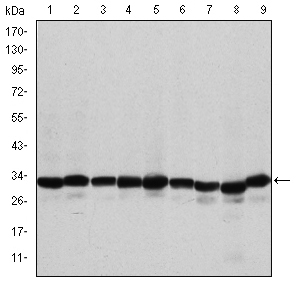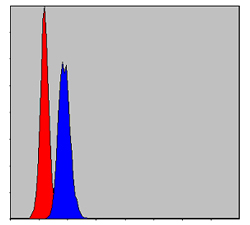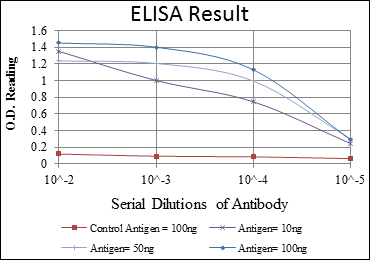Prohibitin Monoclonal Antibody
- Catalog No.:YM0537
- Applications:WB;IHC;IF;FCM;ELISA
- Reactivity:Human;Mouse;Rat;Monkey
- Target:
- Prohibitin
- Gene Name:
- PHB
- Protein Name:
- Prohibitin
- Human Gene Id:
- 5245
- Human Swiss Prot No:
- P35232
- Mouse Gene Id:
- 18673
- Mouse Swiss Prot No:
- P67778
- Rat Gene Id:
- 25344
- Rat Swiss Prot No:
- P67779
- Immunogen:
- Purified recombinant fragment of human Prohibitin expressed in E. Coli.
- Specificity:
- Prohibitin Monoclonal Antibody detects endogenous levels of Prohibitin protein.
- Formulation:
- Liquid in PBS containing 50% glycerol, 0.5% BSA and 0.02% sodium azide.
- Source:
- Monoclonal, Mouse
- Dilution:
- WB 1:500 - 1:2000. IHC 1:200 - 1:1000. IF 1:200 - 1:1000. Flow cytometry: 1:200 - 1:400. ELISA: 1:10000. Not yet tested in other applications.
- Purification:
- Affinity purification
- Storage Stability:
- -15°C to -25°C/1 year(Do not lower than -25°C)
- Other Name:
- PHB;Prohibitin
- Molecular Weight(Da):
- 30kD
- References:
- 1. Biochem Biophys Res Commun. 2009 Dec 18;390(3):1023-8.
2. J Cell Biochem. 2009 Nov 1;108(4):926-34.
- Background:
- prohibitin(PHB) Homo sapiens This gene is evolutionarily conserved, and its product is proposed to play a role in human cellular senescence and tumor suppression. Antiproliferative activity is reported to be localized to the 3' UTR, which is proposed to function as a trans-acting regulatory RNA. Several pseudogenes of this gene have been identified. Alternative splicing results in multiple transcript variants. [provided by RefSeq, Jul 2013],
- Function:
- developmental stage:Levels of expression in fibroblasts decrease heterogeneously during cellular aging.,disease:Mutated in sporadic breast cancer.,function:Prohibitin inhibits DNA synthesis. It has a role in regulating proliferation. As yet it is unclear if the protein or the mRNA exhibits this effect. May play a role in regulating mitochondrial respiration activity and in aging.,induction:Expression increases approximately 3-fold upon entry into G1 phase compared with other phases of the cell cycle. Also induced following inhibition of mitochondrial protein synthesis by thiamphenicol.,similarity:Belongs to the prohibitin family.,subunit:Interacts with PHB2.,tissue specificity:Widely expressed in different tissues.,
- Subcellular Location:
- Mitochondrion inner membrane . Nucleus . Cytoplasm . Cell membrane .
- Expression:
- Widely expressed in different tissues.
- June 19-2018
- WESTERN IMMUNOBLOTTING PROTOCOL
- June 19-2018
- IMMUNOHISTOCHEMISTRY-PARAFFIN PROTOCOL
- June 19-2018
- IMMUNOFLUORESCENCE PROTOCOL
- September 08-2020
- FLOW-CYTOMEYRT-PROTOCOL
- May 20-2022
- Cell-Based ELISA│解您多样本WB检测之困扰
- July 13-2018
- CELL-BASED-ELISA-PROTOCOL-FOR-ACETYL-PROTEIN
- July 13-2018
- CELL-BASED-ELISA-PROTOCOL-FOR-PHOSPHO-PROTEIN
- July 13-2018
- Antibody-FAQs
- Products Images

- Western Blot analysis using Prohibitin Monoclonal Antibody against A431 (1), MCF-7 (2), Jurkat (3), HeLa (4), HepG2 (5), A549 (6), NIH/3T3 (7), Cos7 (8) and PC-12 (9) cell lysate.

- Immunohistochemistry analysis of paraffin-embedded rectum cancer tissues with DAB staining using Prohibitin Monoclonal Antibody.

- Immunofluorescence analysis of NIH/3T3 cells using Prohibitin Monoclonal Antibody (green). Blue: DRAQ5 fluorescent DNA dye. Red: Actin filaments have been labeled with Alexa Fluor-555 phalloidin.

- Flow cytometric analysis of MCF-7 cells using Prohibitin Monoclonal Antibody (blue) and negative control (red).




